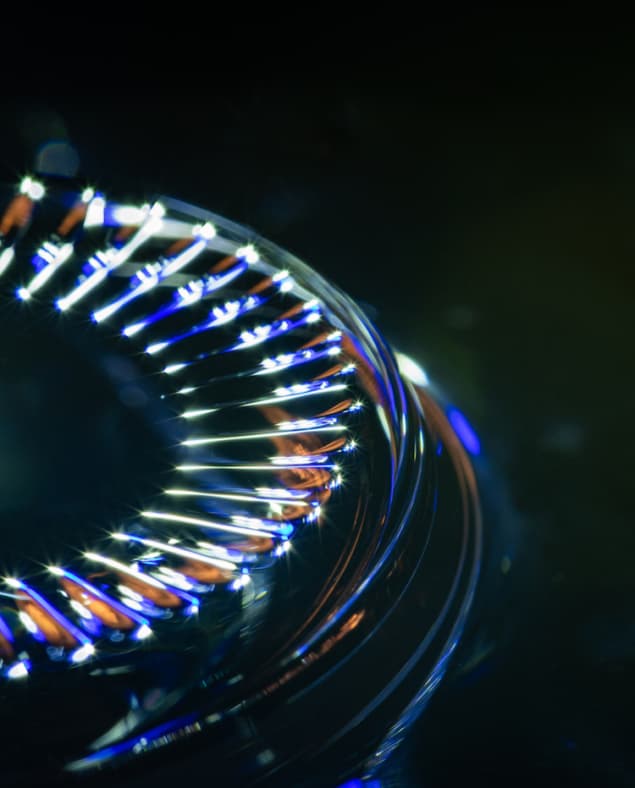
What causes a bubble to burst? For bubbles on the surface of viscous liquids such as paint or lava, the finger of blame has long pointed to gravity. Now, however, researchers led by James Bird at Boston University in the US have turned this idea literally on its head, using an upside-down bubble-testing rig to show that surface tension, not gravity, is at fault. Their result has implications for industrial processes such as glass manufacturing and spray painting and could even shed light on the break-up of respiratory aerosols – a phenomenon that has taken on extra significance due to the COVID-19 pandemic.
When a bubble rises to the surface of a liquid, it typically forms a thin, liquid, dome-shaped film supported by the gas trapped inside it. Once this film develops a hole, surface tension causes the film to retract further, and the bubble bursts.
In runny, low-viscosity liquids, the bursting process is over in a matter of milliseconds. In thicker, viscous fluid, it takes longer, yet the film collapses when the hole is barely open. The reason is that as soon as the hole forms, trapped gas can escape from the bubble. Without the support of this gas, the forces on the liquid film become unbalanced, causing the bubble to collapse and radial wrinkles to form around the bubble’s edge – rather like what happens in an elastic sheet, or a parachute.
Exploiting super-slow flow
Until now, scientists thought that the weight of the thin liquid film was responsible both for the bubble’s collapse and for the formation of the radial wrinkles – suggesting that gravity was the main factor behind viscous bubble bursting.
Bird and colleagues set out to test this hypothesis by injecting an air bubble into a viscous silicone oil and filming the bubble’s collapse with a high-speed camera. Their first experiments were aimed at replicating how viscous bubble collapse had been studied in the past. Once they accomplished that, however, they did something different: they changed the orientation of the bubble relative to gravity. This, Bird says, was possible because of the extreme viscosity of their test liquid. “We exploited this super-slow flow by preparing the bubble in an upright position and then rapidly turning it upside down, quickly puncturing it before it could significantly readjust its shape,” he explains.
In these upside-down experiments, the researchers varied the thickness of the films and the viscosity of the fluid, while also providing a way for the air inside a bubble to escape without rupturing the film. Their results showed that gravity plays only a negligible role in bubble collapse. Instead, it is surface tension and the dynamic stress of the liquid that forms the bubble that are the main drivers of viscous bubble behaviour – including the formation of unstable wrinkles.
A delicate interplay of forces
This finding is exciting, Bird says, because it shows that such forces also play a role in situations where they might otherwise be overlooked – for example, at especially small scales and for multiple orientations of bubbles. It is also important because it resolves a longstanding paradox: while surface tension normally smooths out wrinkles, in this case it also initiates them.
“It is through a delicate interplay of capillary, viscous and inertial forces that wrinkles develop,” he tells Physics World. “Indeed, it took us a day to show that surface tension was responsible for the wrinkles and over a decade to adequately explain why.”
A timely result
Bird and colleagues say that the results of their study have implications wherever curved viscous films are prevalent – either because the surrounding liquid is highly viscous (as is the case for bubbles in molten glass or lava) or because the bubble is small (such as in bubbles that form on coated films). Since the wrinkling and folding of liquid films can trap air, the transport of heat and mass at a liquid interface will be affected, too.

Physicists create droplets inside bubbles
The retraction and collapse dynamics the researchers uncovered will also influence any breakup or aerosolization of the thin film. “A timely example of where our study could be applicable involves the mechanism by which respiratory aerosols form when we breathe and speak,” says Bird. “These aerosols are believed to develop when thin, curved films repeatedly develop across small airways in the lungs and then rupture. Since surface tension rather than gravity is important for the collapse and viscous buckling instability, it is possible that it is also relevant in these films.”
The team, which includes researchers in applied mathematics at the Massachusetts Institute of Technology and the Department of Mechanical and Aerospace Engineering at Princeton University, has developed a theoretical model to explain their observations. They now hope to extend it to more complex liquids, such as viscoelastic fluids that have both liquid and solid-like behaviours. “For example, in respiratory tract fluids, elastic and dynamic surface tension are present and these might modify the phenomenon in interesting and unexpected ways,” says study lead author Alexandros Oratis.
The researchers also intend to explore the precise ways that a film’s thickness profile develops, and how this affects (and is affected by) the bubble collapse. They detail their work in Science.



